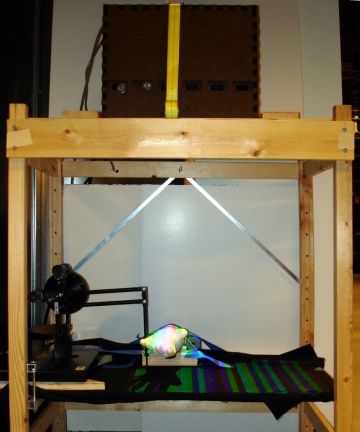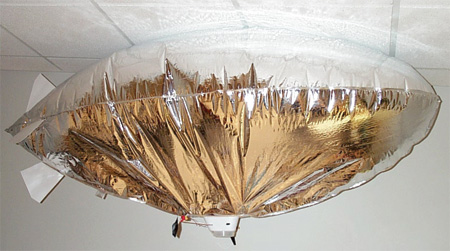- Home
- Projects:
- Research
- Random Stuff I've Made/Built
Research
At Stanford:
At Stanford I was a member of Prof. Jean-Claude
Latombe's research group in the Robotics Lab (which has been
renamed the Stanford Artificial Intelligence Lab.) I also
worked closely with Prof. Ken
Salisbury's group.I worked on and/or was involved with research on sensing and modeling deformable objects, surgical simulation, and climbing robots.
I appreciate a BibTex file for easy citations. So, here is a BibTex file with citations for the papers listed on this page.
The following copyright notice applies to all papers below appearing in IEEE sponsored publications:
Copyright IEEE.
Personal use of this material is permitted. However, permission to
reprint/republish this material for advertising or promotional purposes
or for creating new collective works for resale or redistribution to
servers or lists, or to reuse any copyrighted component of this work in
other works, must be obtained from the IEEE. Contact: Manager,
Copyrights and Permissions / IEEE Service Center / 445 Hoes Lane / P.O.
Box 1331 / Piscataway, NJ 08855-1331, USA. Telephone: + Intl.
732-562-3966.
Capturing and Rendering Behavior of
Elastic Deformable Objects

I used the 3D sensor described below and a PHANtOM haptic device as a robot to capture the behavior of elastic deformable objects. The measurements are transformed into a data-based model for interactive playback.
Papers:
- Philip Fong. "Sensing, Acquisition, and Interactive
Playback of Data-based Models for Elastic Deformable Objects," The International Journal of Robotics
Research, 2009 28: 622-629. [Unfortunately IJRR prohibits
posting articles on-line for one year. You must buy a copy from
them. I suggest looking at my thesis which I based this article
on.]
- See also my thesis
High Speed 3D Sensing
I designed and built a high speed 3D sensor.
This system is used in various applications including sensing
deformations while a robot is exciting an object (see above). The
sensor
generates one range map per video frame and can be used to study fast
moving
and deforming objects.Poster:
- Range Sensing of Dynamic and Deformable Objects Presented at 2003 Computer Forum Annual Meeting
Papers:
- P. Fong and F. Buron. "High-Resolution Three-Dimensional Sensing of Fast Deforming Objects," IEEE/RSJ International Conference on Intelligent Robots and Systems (IROS), August 2005, Edmonton, Alberta, Canada
- P. Fong and F. Buron. "Sensing Moving and Deforming Objects with Commercial Off the Shelf Hardware," IEEE International Workshop on Projector-Camera Systems (PROCAMS), June 2005, San Diego CA, USA
- See also my thesis
Pictures/Videos:
These videos are compressed with Xvid.
- Video (2.6 MB) showing a water balloon bouncing around. It was shot at 100 fps but plays back at 15 fps so you can see what's happening.
- Video (1.8 MB) showing a person moving a popcorn tin around.
- Video (2.0 MB) showing a flag being waved side to side.
Robot Racing
I was also part of the Stanford
Racing Team which is Stanford's DARPA Grand Challenge
effort. We won the 2005 DARPA Grand Challenge.- S. Thrun, M. Montemerlo, H. Dahlkamp, D. Stavens, A. Aron,
J. Diebel, P. Fong, J. Gale, M. Halpenny, G. Hoffmann, K. Lau, C.
Oakley, M. Palatucci, V. Pratt, P. Stang, S. Strohband, C. Dupont,
L.-E. Jendrossek, C. Koelen, C. Markey, C. Rummel, J. van Niekerk, E.
Jensen, P. Alessandrini, G. Bradski, B. Davies, S. Ettinger, A.
Kaehler, A. Nefian, and P. Mahoney. "Winning
the DARPA Grand Challenge," Journal
of Field Robotics, Vol 23, Issue 9 2006
Thesis
My thesis describes the design and implementation of an automated system to create and render models of elastic deformable objects in interactive haptics-enabled environments. The version here uses JPEG compression on some figures in order to reduce the download size.- P. Fong. Data-based Models for Deformable Objects: Sensing, Acquisition, and Interactive Playback. PhD Thesis, Stanford University, June 2007
- Also see above for additional material on 3D Sensing and Deformable
Modeling
Industry:
During my internship at Lawrence Livermore National Laboratory, I worked on modeling digitizers and image processing for the National Ignition Facility.Papers:
- P. Fong, A. Teruya, and M. Lowry. "Characterization and
Compensation of High Speed Digitizers," IEEE
Instrumentation and Measurement Technology Conference (IMTC),
Ottawa, Canada. May 2005
- L.M. Kegelmeyer, P. Fong, S.M. Glenn, and J. Liebman.
“Local Area Signal-to-Noise Ratio
(LASNR) algorithm for Image Segmentation”, SPIE: Applications of Digital Image
Processing XXX. San Diego. August 2007.
Copyright 2007 Society of Photo-Optical Instrumentation Engineers.
This paper was published in Proc. SPIE Vol. 6696 - Applications of Digital Image Processing XXX and is made available as an electronic reprint with permission of SPIE. One print or electronic copy may be made for personal use only. Systematic or multiple reproduction, distribution to multiple locations via electronic or other means, duplication of any material in this paper for a fee or for commercial purposes, or modification of the content of the paper are prohibited.
- Characterization and Compensation
of High Speed Digitizers contains color versions of figures in the
paper
Past:

At Carnegie Mellon, I built a robotic blimp for my Honor's research project and continued work on it in 18-474 Feedback Controls. The project won the Lockheed Martin Judge's Choice award at the 2001 Meeting of the Minds.
Poster:
- Remote Inspection Using Aerial Vehicles: A Flying Robot Platform - Presented at 2001 Meeting of the Minds